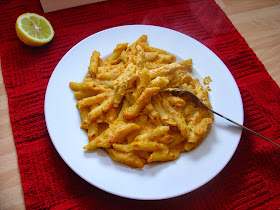One day, when I was sloping around the internet looking for recipes, I stumbled across this delicious-looking one for Pambazos by Warren Elwin, and thought I have to make this vegan. Pambazos are salsa-coated fried sandwiches from Mexico. I filled this one with vegan sausage, capsicum and potato and topped it with coleslaw. Wrapping them in paper before you eat them is a good idea if you don't want to be covered in sticky salsa.
Pambazos
Inspired by this recipe.
Serves 4
Ingredients
500 ml red cabbage
1 tbsp white wine vinegar
1 tbsp sugar
1 tsp salt
1 onion
1 capsicum
2 cloves garlic
1 pack vegan sausages or chorizo
3 potatoes
1 tbsp smoked paprika
1/2 tsp cayenne powder
1 tsp salt
a pinch black pepper
4 big ciabatta-style rolls
lots of salsa
vegan margarine
Method
1. Thinly slice red cabbage. Toss with vinegar, sugar and salt. Set aside. Peel, dice and boil the potatoes.
2. Dice onion and capsicum and mince garlic. Heat 1 tbsp margarine in a pan over medium heat. Fry vegetables for 10 minutes, or until soft. Chop up the sausages, add and fry for 5 more minutes. Remove mixture from the pan.
3. Add 1 tbsp more margarine to the pan and fry potatoes until browned, about 10 minutes. Add the spices to the pan, along with the fried vegetables and sausages. Mix well and fry for a few more minutes. Remove from the pan.
4. Cut rolls in half, remove some of the dough from the inside, and coat completely in salsa. Add 1 tbsp margarine to the pan. Fry two at a time on both sides until browned. Add more margarine between batches as needed.
5. Put the filling on the rolls and top with coleslaw. Wrap in paper or foil and enjoy!







